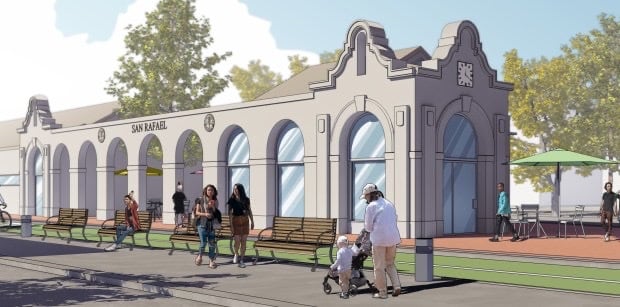Transportation officials weigh in on San Rafael Transit Center
March 7, 2024
By: KRISSY WAITE | Marin Independent Journal

A view of the customer service building along Tamalpais Avenue from a presentation of conceptual designs for the San Rafael Transit Center renovation. (Rendering by Dialog Consultants)
Transportation agencies in Marin County lent their support to the latest plans to redesign the San Rafael Transit Center.
In the last week, the Golden Gate Bridge, Highway, and Transportation District, which owns the site, presented updates on the project to the boards of Sonoma-Marin Area Rail Transit and the Transportation Authority of Marin.
At a meeting Wednesday, SMART directors said they liked what they saw, especially the work to include the community’s thoughts and ideas.
Board member Kate Colin, the mayor of San Rafael, said she would like to see the progression of plans from the beginning to end based on community outreach. She said the city was concerned at first, but that the project was in a “much better place” now.
“We talk a lot about getting feedback from the community and from the riders,” Colin said. “What I will look for in March is I want specific examples. I find sometimes as agencies we say that, we show them and we’re like, ‘Hey, how is this?’ and people are like ‘Oh, OK, that’s great,’ but I actually really want to hear how your original design changed from that input.”
The $50 million to $70 million plan would move the transit center one block north of its location between Third and Fourth streets.
Over the past year, the bridge district has been working with Canal neighborhood residents to help design the new center via video chats, open houses and an advisory group.
“The community is behind us on this project,” Ron Downing, a planner with the bridge district, told the SMART board. “And so moving forward you will see some design concepts that have been embraced and that will inform our preliminary engineering phase that will come next.”
In updated plans based on the community feedback, the Whistlestop building will reflect the historic nature that dates back to the 1920s railroad era — as best as possible due to limited records. The depot entry will be the public lobby, the middle section will become a public courtyard and another section will have retail space and a cafe.
East of the SMART tracks, there are plans for a large bus canopy to create a more aesthetically pleasing architectural design entrance to the city — in contrast to a pool of buses.
Patty Garbarino, a member of the bridge district board, echoed Colin’s approval of the community feedback efforts.
Board member Gabe Paulson, a Larkspur councilmember, asked if efficiency has been considered in the plans, such as electrification, and the amount of transportation in the future.
“I appreciate the historical elements of the design, but what about looking ahead 10 or 20 years?” Paulson said.
Downing said the plans include an environmental analysis. He said from an environmental perspective they did not increase the number of bus bays or buses in the transit center, but that system can operate more effectively because more can pass through per hour and pull around buses that are delayed for any reason.
Board member Mary Sackett, a Marin County supervisor, said the plans should account for future riders — younger generations of transit users who are less interested in owning cars.
“So making sure we’re asking the 18- to 20-year-olds what do you want to see in a transit center and really ensuring that we are creating something to attract new riders,” Sackett said.
The Transportation Authority of Marin’s board of commissioners heard a similar presentation Thursday.
Commissioner Urban Carmel, the mayor of Mill Valley, said he likes the idea of bringing back historic elements of the building. He suggested the district look at how Mill Valley restored the train depot for inspiration.
“I think your design looks fantastic,” Carmel said, “I really like what you’ve done with the whole thing. I really like the fact that you’re harking back to 1929.”
Nancy Kemnitzer, a member of the Belvedere City Council, asked if the community feedback included seniors or any of the committees or councils focused on aging. Staff with the bridge district said it does.
“Senior, by the way, in Marin is about half of us, if you’re looking at over 60,” Kemnitzer said.
Kemnitzer suggested the district reach out to “age friendly cities,” a global initiative by the World Health Organization, for feedback.
The bridge district is still working with the city on allocating the responsibility of Tamalpais Avenue, the North-South Greenway configuration and the design review process, said Adam Dankberg, a project manager with consultant Kimley-Horn Consultants.
The bus bay configuration is being coordinated with Marin Transit. The design of the street crossing is being coordinated with the city, SMART, Marin Transit and the California Public Utilities Commission.
Next steps include presenting the plan to the San Rafael City Council and the bicycle and pedestrian advisory committee, finishing the preliminary engineering and getting National Environmental Policy Act clearance.
Construction on the project is estimated to begin in 2026 and take a year to finish.
More information about the project, the workshop and committee meeting are at bit.ly/3RoZMDq.
Read the story on the Marin IJ